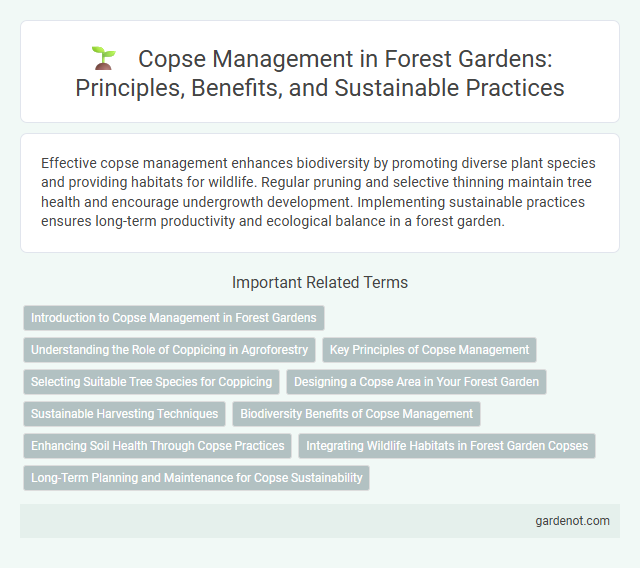Effective copse management enhances biodiversity by promoting diverse plant species and providing habitats for wildlife. Regular pruning and selective thinning maintain tree health and encourage undergrowth development. Implementing sustainable practices ensures long-term productivity and ecological balance in a forest garden.
Introduction to Copse Management in Forest Gardens
Copse management in forest gardens involves the strategic cultivation and periodic harvesting of small woodland areas to promote biodiversity and sustainable resource use. This practice enhances ecosystem services by maintaining a diverse mix of native tree species, encouraging natural regeneration, and supporting wildlife habitats. Effective copse management balances human needs such as fuelwood and forage with conservation goals, fostering resilience and productivity within the forest garden system.
Understanding the Role of Coppicing in Agroforestry
Coppicing plays a crucial role in agroforestry by promoting sustainable wood production and enhancing biodiversity within a forest garden. This traditional method involves periodically cutting back trees near ground level to stimulate new growth, which improves soil fertility and supports diverse understory plants. Effective copse management through coppicing optimizes light penetration and nutrient cycling, fostering a resilient and productive ecosystem.
Key Principles of Copse Management
Effective copse management in forest gardens emphasizes maintaining biodiversity by promoting native species regeneration and controlling invasive plants. Regular selective thinning enhances light penetration, encouraging understorey growth and increasing habitat complexity. Soil health is preserved through minimal disturbance practices, fostering sustainable nutrient cycling and supporting diverse flora and fauna.
Selecting Suitable Tree Species for Coppicing
Selecting suitable tree species for coppicing in forest garden copse management involves prioritizing species with strong regrowth ability and high economic or ecological value, such as hazel, willow, and chestnut. These trees offer rapid shoot regeneration and provide sustainable wood, fuel, or habitat resources. Proper species selection enhances biomass production and supports biodiversity within a managed coppice system.
Designing a Copse Area in Your Forest Garden
Designing a copse area in your forest garden involves selecting a diverse mix of native tree species that thrive together, promoting biodiversity and ecosystem resilience. Careful spacing and layering of canopy, understory, and ground cover plants optimize sunlight exposure and nutrient cycling, enhancing overall productivity. Integrating coppicing techniques within the design encourages sustainable wood harvesting while supporting wildlife habitats and soil health.
Sustainable Harvesting Techniques
Copse management in forest gardens emphasizes sustainable harvesting techniques that maintain biodiversity and soil health. Selective pruning and rotational coppicing ensure continuous resource availability without compromising tree regeneration. Integrating native species and monitoring growth cycles optimizes yield while preserving ecological balance.
Biodiversity Benefits of Copse Management
Copse management enhances biodiversity by fostering a diverse understory and supporting various wildlife habitats, including birds, insects, and small mammals. Regular thinning and selective pruning create structural diversity in vegetation layers, promoting species-rich environments and improving ecosystem resilience. Maintaining a well-managed copse also aids in nutrient cycling and soil health, contributing to overall forest garden productivity.
Enhancing Soil Health Through Copse Practices
Copse management significantly boosts soil health by promoting organic matter accumulation through leaf litter and woody debris decomposition. Implementing selective thinning and maintaining diverse tree species enhances microbial activity and nutrient cycling essential for soil fertility. These practices improve soil structure, moisture retention, and support a thriving ecosystem within the forest garden environment.
Integrating Wildlife Habitats in Forest Garden Copses
Effective copse management in forest gardens emphasizes creating diverse wildlife habitats by incorporating native shrub layers, deadwood, and varied plant species to support birds, insects, and small mammals. Enhancing structural complexity with layered vegetation and leaving natural features undisturbed increases biodiversity and ecological resilience. Regular monitoring and adaptive management ensure these habitats meet the needs of key species while maintaining forest garden productivity.
Long-Term Planning and Maintenance for Copse Sustainability
Effective copse management involves strategic long-term planning that prioritizes biodiversity, soil health, and species balance to ensure forest garden sustainability. Implementing rotational thinning and selective pruning supports natural regeneration while maintaining habitat complexity for wildlife. Regular monitoring and adaptive maintenance practices help address pest outbreaks and disease, promoting a resilient and productive copse over time.
Copse management Infographic

 gardenot.com
gardenot.com